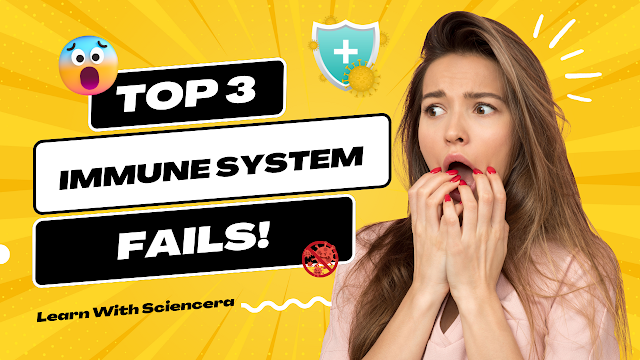Three ways in which immune system fails include:
1. Autoimmune Disorders
Autoimmune disorders, man, they're when your immune system, like, attacks your own body instead of just protecting you from, like, outside invaders. Your immune system, it's supposed to know the difference between, like, you and a virus, right? But with these disorders, it's all messed up, and it starts attacking your own cells and tissues.
One example is rheumatoid arthritis. It's when your joints, man, they get all swollen and hurt. The immune system, it goes after this stuff called the synovium, which is like the lining of your joints. So, like, it causes inflammation, pain, and over time, it can damage the cartilage and bone in your joints. Lupus is another one of these disorders, and it can affect, like, a bunch of different parts of your body, like your skin, joints, kidneys, and even your heart. It causes joint pain, skin rashes, fatigue, and sometimes organs don't work right.
The exact causes of these disorders, they're not really clear, but they're probably some combination of genes you got from your parents and stuff in your environment, you know? And the immune system, it's all screwed up, too. Treatments, they're supposed to help you feel better and slow down the immune system, but there's no real cure for these disorders, you know? So, there's a lot of research going on and stuff, trying to find new ways to help people.
2. Immunodeficiency disorders
In contrast to autoimmune disorders where the immune system attacks the body's own healthy cells, immunodeficiency disorders are caused by a weakened or impaired immune system, leaving the body more susceptible to infections. There are two main types of immunodeficiency disorders: congenital, which are caused by genetic defects that affect the development or function of immune cells, and acquired, which occur as a result of infections, medications, or other factors that compromise immune function.
One of the most well-known acquired immunodeficiency disorders is HIV/AIDS, brought on by the human immunodeficiency virus (HIV). HIV specifically targets and destroys CD4 T cells, a type of white blood cell that's crucial for coordinating the immune response against infections. As the number of CD4 T cells decreases, the immune system becomes progressively weaker, making it harder for the body to fight off infections and other diseases.
Primary immunodeficiency disorders, on the other hand, are a group of rare genetic conditions that interfere with the immune system's ability to fight off infections. Examples of these disorders include severe combined immunodeficiency (SCID), where individuals are born with almost no functioning immune system, and common variable immunodeficiency (CVID), where the body doesn't produce enough immunoglobulins, which are proteins needed for antibody production.
The management of immunodeficiency disorders typically involves a combination of supportive care, such as antibiotics to prevent and treat infections, and immune-modulating therapies like immunoglobulin replacement therapy for individuals with antibody deficiencies. In severe cases, bone marrow or stem cell transplantation may be considered as a potential cure.
3. Hypersensitivity
Allergic reactions happen when our immune systems freak out over stuff it thinks is bad for us, even though it's usually not. Like, it's supposed to protect us from germs and stuff, but in people with allergies, it gets confused and thinks harmless things like pollen, dust mites, pet dander, or certain foods are super dangerous.
So, when we're exposed to one of these "allergens," our immune system makes special proteins called immunoglobulin E (IgE) that hang out with these mast cells and basophils, which are two types of immune cells. Then, the next time we're exposed to the same allergen, those IgE proteins tell the mast cells and basophils to release stuff called inflammatory mediators, like histamine. That's what causes the classic allergy symptoms, like itching, swelling, hives, stuffy nose, and sometimes even anaphylaxis, which can be serious.
Allergies can show up in lots of different ways, from a little itchy nose (hay fever) to bigger deals like asthma, eczema, and food allergies. Most of the time, allergies can be managed by avoiding the stuff we're allergic to and taking medicine like antihistamines and steroids. But, if it's bad, we might need an epinephrine shot (adrenaline) to stop life-threatening stuff from happening.
So, basically, allergies are just our immune systems being a little overprotective and accidentally making us feel crummy sometimes. But it could be worse, right?
Different types of Hypersensitivity:
Type 1 hypersensitivity
It refers to hypersensitivity reactions that occur instantly. Immunoglobulin E causes mast cells and basophils to produce histamine and other mediators (IgE). The initial interaction with the allergen is usually uneventful; nevertheless, it can result in the creation of IgE molecules, which attach to the mast cell surface. The person becomes allergic to the allergen because of this.
Type 2 hypersensitivity
It refers to cytotoxic hypersensitivity responses. Antibodies to IgG or IgM are involved. Complement fixation occurs when these antibodies bind to cell surface antigen. This usually entails the killing of foreign cells once they have been marked with antibodies and complement has been activated. When a person having one kind of blood is donated another type of blood, this is an example.
Type 3 hypersensitivity
It is characterized by the development of immunological complexes, which may eventually be deposited in the presence of too much soluble antigen, resulting in complement activation and tissue injury.
Type 4 hypersensitivity
It refers to delayed hypersensitivity reactions that are mediated by immune cells such as T cells rather than antibodies. Contact dermatitis involving poison ivy, or a nickel allergy are two examples.
- Prescott, Harley & Klein, Microbiology, Willey J, Sherwood L and Woolverton C, 2017.
- Microbiology, 10th edition. McGraw-Hill, New York, USA. ISBN 9789813151260
- OpenStax College, Anatomy and Physiology. OpenStax CNX.







.jpg)

.png)
0 Comments